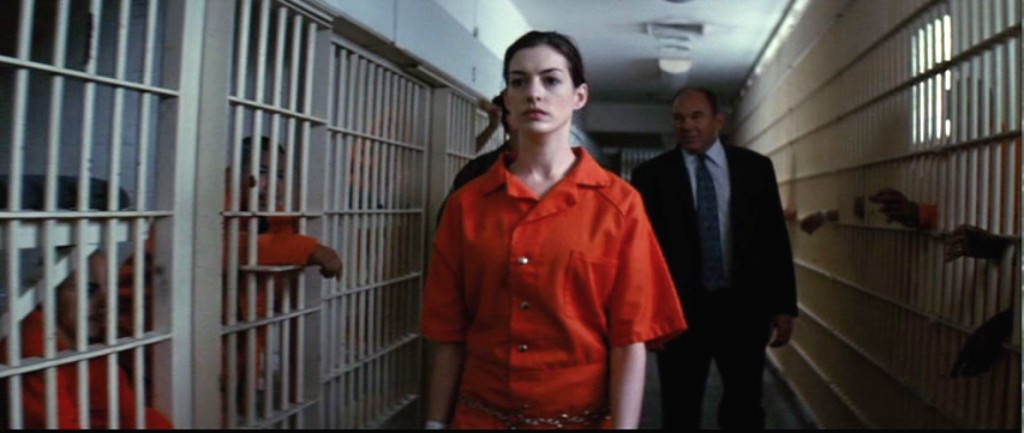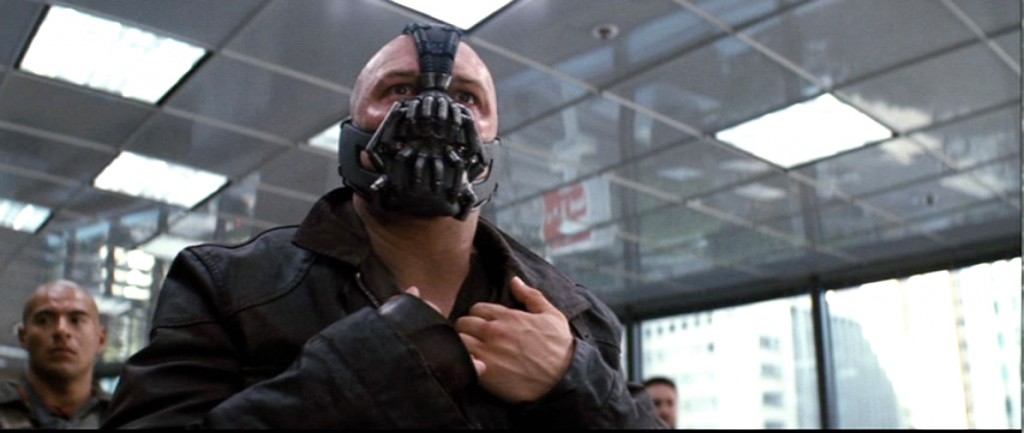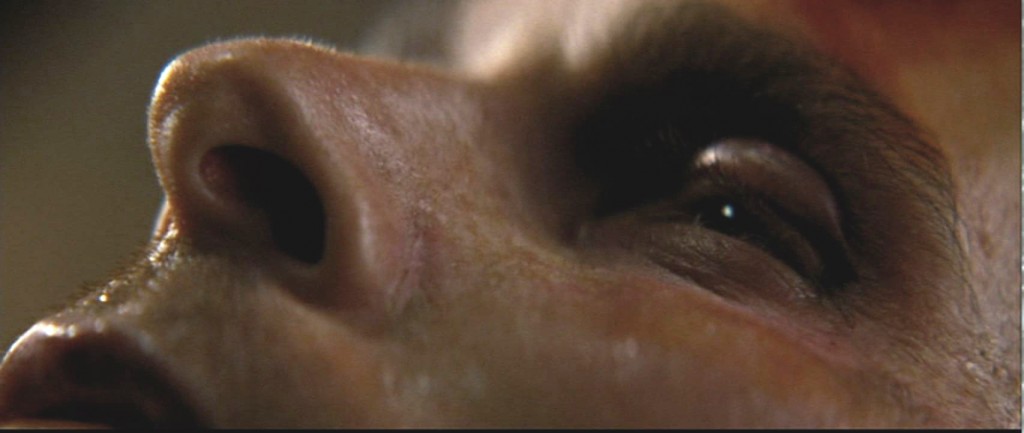Batman: The Dark Knight Rises part 9
Act IV of The Dark Knight Rises begins by checking in with Selina, who is being held at Blackgate Prison for kidnapping the congressman back in Act I. The screenplay takes care to note that Selina, despite her seeming vulnerability amidst a population of convicted criminals, can take care of herself in the worst of circumstances. The script presents this as a physical gag, but it’s important to keep in mind that Selina, as an anti-Batman (and anti-Bruce) (they’re both in prisons at this point), is still at her physical peak compared to Bruce. Bruce is in prison at Bane’s hand, but Selina is in hers by her own hand. One could ask if either character “deserves” his or her imprisonment, and do well to do so, it’s kind of the question of the moment as the narrative moves forward. “Deserves” is that most moveable of moral ends, especially in regards to crime and punishment, and it exists always in relation to its society. Does Bruce “deserve” to lie, broken, in a foreign prison while Bane plots to destroy his own city with the fruits of his own wealth? How many men lie in Blackgate on this day as a result of Bruce’s actions, and how many of them consider themselves innocent or misunderstood? Does Selina “deserve” to be in prison, when she has hurt no one who couldn’t afford it, and only wants to get by in a society that won’t let her forget her past? (Fantine! Although Selina has it much better than Fantine, she doesn’t have to cut her hair, pull her teeth or die of tuberculosis, and she’s developed keen fighting skills to deal with the men who might brutalize her.) “The Dent Act” is mentioned as covering a woman placed in Blackgate (why Selina is in a prison instead of a jail, when she has been convicted of nothing, is another question), and we are meant to understand that the Dent Act has been perhaps overreaching in its efforts to clean up Gotham, which raises all kinds of uncomfortable questions of the authority we grant to the police (and the army) to deal with the people we don’t want to deal with. The Thin Blue Line, we remember, exists primarily to keep property in the hands that have it. Possession is nine-tenths of the law, the police are attack dogs of the possessors. (Funny how the wealthiest wish to avoid paying taxes to the government that keeps their wealth safe and growing.)
Over at Wayne Enterprises, Miranda shows up for her first day at work to find that Bane has taken over the boardroom. The first step to his revolution, he knows, is not to storm the Bastille (that comes later) but to storm the boardroom. And yes, the screenplay works the drama of this situation — who has not wanted to storm a corporate boardroom to hold the fatcats accountable for their sins? The screenplay suggests, again, for the purposes of drama, that the viewer has been rooting for the wrong people all along. And we remember Lucius gloating over his latest top-secret weapons project, secure that his boss, Bruce, will keep all his toys to himself, for the sake of the public good. Bane takes Miranda, Lucius and another board member (who might as well be wearing a red shirt) down to the sewers.
Over at the hospital, Foley reports to Gordon (and Blake, who seems to outrank Foley at this point — Foley can barely look him in the eye) about the Wayne Enterprises situation (talk about a hostile takeover!) and Gordon gives him marching orders to mobilize the entire police force — the entire police force — to protect the interests of Wayne Enterprises (and, parenthetically, to catch Bane). (Foley is played by Matthew Modine, who, the viewer will recall, played Pvt Joker in Full Metal Jacket. Pvt Joker (Joker!) tracked a tricky moral course through that morally ambiguous movie and emerged hardened but no wiser. Foley, on the other hand, seems to never have been hardened, morally or otherwise. He’s a pure example of a governmetal bureaucrat, a man born to take orders and cover his ass.) (Surely he is unrelated to Axel Foley of Beverly Hills Cop, a rulebreaker if there ever was one. He’s more probably related to Mark Foley, the congressman who got ousted for flirting with under-age pages.)
Meanwhile, Bruce lies in agony in the pit and we meet two new characters, “Prisoner” and “Blind Prisoner,” a Beckettian pseudocouple for this Beckettian set, who will act as a kind of two-man Yoda team to coach Bruce back to the surface. They tell Bruce that there is one who long ago escaped the pit (Bruce assumes they mean Bane) but that the escapee is merely a legend. There’s that word again — Bruce wished to trascend mortality by becoming a legend as Batman, Bane also has put on a mask to that end. Ra’s Al Ghul did more than put on a mask, he subsumed his entire identity to his League of Shadows, letting another man carry his name while he presented himself as just another cog in the machine.
The entire Gotham police force, headed by Foley but ordered by Gordon, head into the sewers to look for Bane. (Javert went alone, but then Javert was only after a broken old man.) Bane, meanwhile, takes his prisoners to Bruce’s fusion reactor (he’s also got Dr. Pavel along) in order to turn Bruce’s power source (source of power?) into a weapon. He needs a Wayne Enterprises board-member’s handprint to start the machine. The red-shirt board member, whose name we never learn, is there not to lend his handprint to the proceedings but to be a hostage, he is there for Bane to point a gun at so that Miranda can step up and turn on the machine in order to save the poor anonymous board member his life (and thus deflect suspicion from herself). Dr. Pavel takes no time at all to turn the reactor into a bomb, and Bane takes out the core, which sets into being a ticking clock — the bomb (for reasons I’m sure are absolutely solid scientifically) will blow up in x amount of time — five months, something of an anomaly in ticking-clock standards. Generally speaking, narratives, especially action narratives, speed up as they reach their conclusion, but The Dark Knight Rises suddenly slows down with over an hour left to go in its runtime. It’s got a lot on its mind, an entire city to lay waste before it’s done.



Although you don’t see the blind doctor and his friend for very long in the scope of the movie, I thought they were really great characters. The blind guy who sees things you can’t see with you eyes is a sort of prophet like in Dante’s Inferno. Christ-like Bruce Wayne descends into hell and gives the doctor that botched Bane’s surgery a chance to redeem himself before rising out of the pit.
Not only does he save the doctor’s soul, but Bruce kicks a rope down to the people in the pit giving them a way out of hell. Hopefully, they have all learned teamwork and take turns leaving the pit, otherwise this will become a Jacob’s Ladder parable.
I find it hard to believe that the gang of prisoners who figured out the rope contraption that allows a prisoner to dangle to death can’t figure out how to make a second rope contraption that the climber can carry in order to reach the crucial ledge.
It’s another case of the “Flying Snowman,” I’m afraid. Of course the entire movie will fall apart if you think about it too hard (even CITIZEN KANE has that “nobody was in the room to hear him speak the word ‘ROSEBUD,’ so why the big hubbub over its meaning?” thing), but since Bane is (supposedly) the only person to ever escape from the pit, it gives broken Bruce a very specific goal to shoot for.
Also, since Bruce’s entire goal has been to become a legend but now Bane has him seemingly beaten at his own game, that our hero is able to (literally and symbolically) rise up out of that pit goes back to the whole “anyone can be Batman” thing: Man may become legend, but that legend, after all, is really just a man.
Do we know that it is the prisoners who made the first rope contraption? I figured it was the prison designer. It lets the prisoners try over and over again, without realizing that it was also causing them to fail. Part of the “give them hope, then take it away” theme.
Again, the movie does a very nice job setting something up without being obvious about it. The redshirt could have been shot, thereby “frightening” Miranda into cooperating, but that’s a standard script move; having her step up before the Nameless Guy dies just feels like “hey, Nolan did a minor twist on the usual motif.” And so you don’t notice (or at least I didn’t notice) until later that waitasec, the whole thing was staged.
The slowdown at the end of the film is indeed startling. I’m not quite sure it’s ideal, either — it’s just necessary, for Bruce to suffer for a while and Gotham to be transformed.
It’s worth noting that the Redshirt Board Member (His name is Fredericks! I finally found it!) is not original to this film. He is in fact a small character from Batman Begins. In Begins we see him standing up for Poppa Wayne’s legacy and expressing disgust at Bruce Wayne’s careless billionaire facade. I don’t think he shows up at all in The Dark Knight, but I really liked them showing him here. He and Lucius are the last remnants of Thomas Wayne’s philanthropic goodness (The very thing that first defeated the League of Shadows prior to Begins). His volunteering to be taken hostage illustrates that he, like Bane, is a believer.
One could argue that Fredericks (well, mostly Lucius, but this guy too) exists to present the similarities of Bruce and Thomas Wayne. They both exist(ed) to inspire. Bruce inspires the lower dregs of society through fear and mystery (darkness), while Thomas inspired the fatcats at the top of the food chain through transparency and charity (light). Bruce’s inspirational legacy creates people like John Blake and Thomas’s creates people like Lucius and Fredericks.
I mostly just liked seeing him show up again though. I love when film series do neat little things like that.
Wow, okay. Go Fredericks!
Fredericks also has a cameo in relation to The Dark Knight. Not in the movie itself, but in something called Gotham Tonight, where the reporter from TDK Mike Engel and co-host Lydia Farangeli (dunno how it’s spelled) has various topics from TDK under discussion. Including interviews with various TDK persons, like Fredericks representing Wayne Corp, and a interview with harvey Dent that’s interrupted with the breaking news that a bank is being robbed, which is the bank heist from the beginning of TDK.
“Fredericks” is played by one John Nolan – Christopher and Jonathan Nolan’s real-life uncle.
I love how a “comic book movie” such as this is able to raise such interesting ideas at seemingly every turn. Dickens, LES MISERABLES, Occupy Wall Street and the 99%, populism vs. fascism… that DKR is able to broach these subjects at all in a billion-dollar-grossing summer studio tentpole is something of a minor miracle. (It is the polar opposite of a movie like THE AVENGERS, which doesn’t have anything specifically on its mind besides entertaining the holy living heck out of you for a couple of hours. Not that this is necessarily a bad thing.)
If nothing else, Nolan has undeniably brought the term “comic book movie” firmly into the realm of the respectable. Comic book movies always made money but they were never respected until The Dark Knight. And it all has to do with the screenwriter’s response to the material. Comic books, as a form, are no more or less legitimate as source material than pulp novels or spy thrillers, and share a lot of the same roots. As I’ve said earlier, one day a “comic book movie” will win Best Picture, there’s no doubt about it, and it will be because movies like The Dark Knight showed how the form could be plumbed for its deeper resonances. It happened with fantasy with Lord of the Rings, it will happen eventually here.
I’m sure if we mapped physical high/lows, we’d find some fun issues: that is, Bane starts in the pit, goes to the sewers, rises to the boardroom for one sort of power, then sinks again to a new low for another sort of power (the generator/bomb), etc.
But what I really love is just how gosh-darn helpful everyone in the Pit is to Batman. I mean, the movie sets this Pit up as a political prison–you don’t have to break any law or be a really bad man to end up there, you just have to offend the whim of the authoritarian ruler. (It’s like the Dent Act for the Third World, or wherever this prison is.)
But it still amuses me that this pit heals, counsels, and chants for Batman. They’re more supportive than some families.
Well, another thing to keep in mind is that the concept of the healing pit comes from the Ra’s Al Ghul character in the comics, where he would use the Lazarus Pit to maintain his immortality.